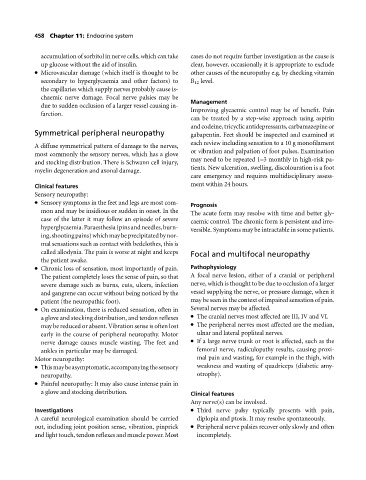Page 462 - Medicine and Surgery
P. 462
P1: FAW
BLUK007-11 BLUK007-Kendall May 25, 2005 8:5 Char Count= 0
458 Chapter 11: Endocrine system
accumulation of sorbitol in nerve cells, which can take cases do not require further investigation as the cause is
up glucose without the aid of insulin. clear, however, occasionally it is appropriate to exclude
Microvascular damage (which itself is thought to be other causes of the neuropathy e.g. by checking vitamin
secondary to hyperglycaemia and other factors) to B 12 level.
the capillaries which supply nerves probably cause is-
chaemic nerve damage. Focal nerve palsies may be
Management
due to sudden occlusion of a larger vessel causing in-
Improving glycaemic control may be of benefit. Pain
farction.
can be treated by a step-wise approach using aspirin
and codeine, tricyclic antidepressants, carbamazepine or
Symmetrical peripheral neuropathy gabapentin. Feet should be inspected and examined at
each review including sensation to a 10 g monofilament
A diffuse symmetrical pattern of damage to the nerves,
or vibration and palpation of foot pulses. Examination
most commonly the sensory nerves, which has a glove
may need to be repeated 1–3 monthly in high-risk pa-
and stocking distribution. There is Schwann cell injury,
tients. New ulceration, swelling, discolouration is a foot
myelin degeneration and axonal damage.
care emergency and requires multidisciplinary assess-
ment within 24 hours.
Clinical features
Sensory neuropathy:
Sensory symptoms in the feet and legs are most com-
Prognosis
mon and may be insidious or sudden in onset. In the The acute form may resolve with time and better gly-
case of the latter it may follow an episode of severe caemic control. The chronic form is persistent and irre-
hyperglycaemia.Paraesthesia(pinsandneedles,burn- versible. Symptoms may be intractable in some patients.
ing,shootingpains)whichmaybeprecipitatedbynor-
mal sensations such as contact with bedclothes, this is
called allodynia. The pain is worse at night and keeps Focal and multifocal neuropathy
the patient awake.
Chronic loss of sensation, most importantly of pain.
Pathophysiology
The patient completely loses the sense of pain, so that Afocal nerve lesion, either of a cranial or peripheral
severe damage such as burns, cuts, ulcers, infection nerve, which is thought to be due to occlusion of a larger
and gangrene can occur without being noticed by the vessel supplying the nerve, or pressure damage, when it
patient (the neuropathic foot). may be seen in the context of impaired sensation of pain.
On examination, there is reduced sensation, often in
Several nerves may be affected.
aglove and stocking distribution, and tendon reflexes The cranial nerves most affected are III, IV and VI.
may be reduced or absent. Vibration sense is often lost The peripheral nerves most affected are the median,
early in the course of peripheral neuropathy. Motor ulnar and lateral popliteal nerves.
nerve damage causes muscle wasting. The feet and Ifa large nerve trunk or root is affected, such as the
ankles in particular may be damaged. femoral nerve, radiculopathy results, causing proxi-
Motorneuropathy: mal pain and wasting, for example in the thigh, with
Thismaybeasymptomatic,accompanyingthesensory
weakness and wasting of quadriceps (diabetic amy-
neuropathy. otrophy).
Painful neuropathy: It may also cause intense pain in
aglove and stocking distribution. Clinical features
Anynerve(s) can be involved.
Investigations Third nerve palsy typically presents with pain,
A careful neurological examination should be carried diplopia and ptosis. It may resolve spontaneously.
out, including joint position sense, vibration, pinprick Peripheral nerve palsies recover only slowly and often
and light touch, tendon reflexes and muscle power. Most incompletely.

